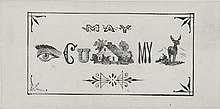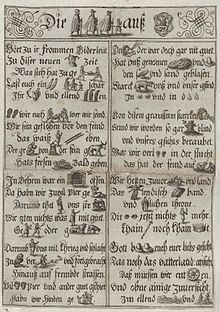
Back ريبوس (لغويات) Arabic Xeroglíficu (ociu) AST Ребус Bulgarian Jeroglífic (passatemps) Catalan Rébus Czech Rebus Danish Bilderrätsel German Rebuso Esperanto Jeroglífico (pasatiempo) Spanish Piltmõistatus Estonian
This article needs additional citations for verification. (August 2021) |


A rebus (/ˈriːbəs/ REE-bəss) is a puzzle device that combines the use of illustrated pictures with individual letters to depict words or phrases. For example: the word "been" might be depicted by a rebus showing an illustrated bumblebee next to a plus sign (+) and the letter "n". It was a favourite form of heraldic expression used in the Middle Ages to denote surnames.
For example, in its basic form, three salmon (fish) are used to denote the surname "Salmon". A more sophisticated example was the rebus of Bishop Walter Lyhart (d. 1472) of Norwich, consisting of a stag (or hart) lying down in a conventional representation of water.
The composition alludes to the name, profession or personal characteristics of the bearer, and speaks to the beholder Non verbis, sed rebus, which Latin expression signifies "not by words but by things"[1] (res, rei (f), a thing, object, matter; rebus being ablative plural).[2]
© MMXXIII Rich X Search. We shall prevail. All rights reserved. Rich X Search